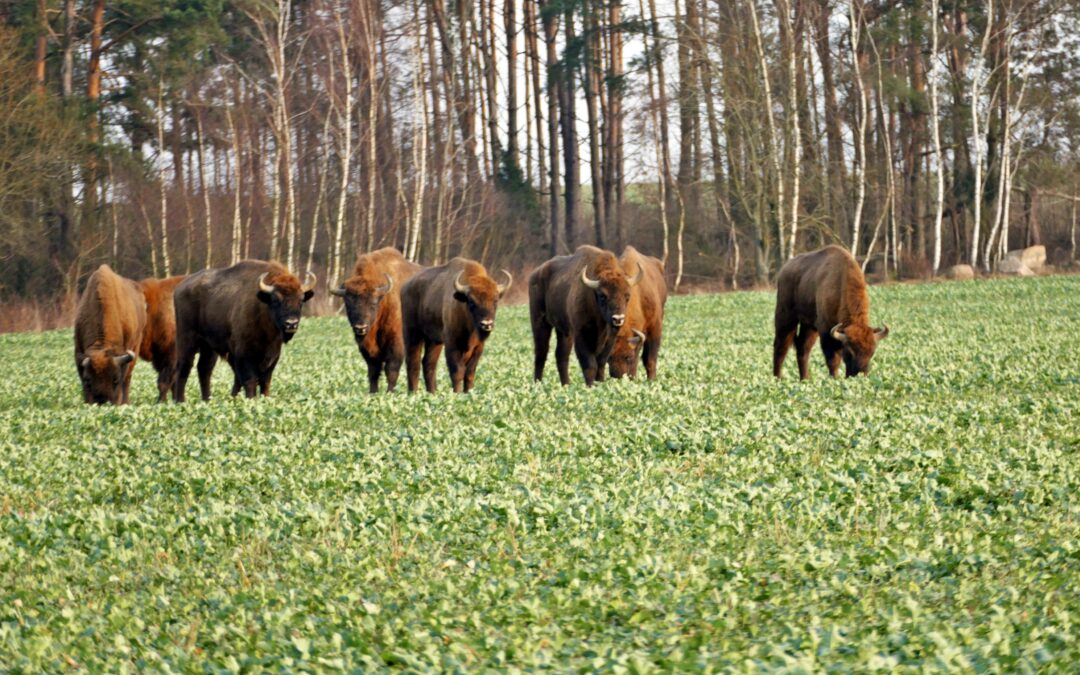Two recently updated “red lists” of threatened species have revealed mixed news for Poland. The country’s iconic bison – once hunted to extinction in the wild – have now been reclassified as no longer “vulnerable”, following a successful programme to reintroduce them.
However, a study on birds shows that 16 species have disappeared completely from the country while many others are under threat. The report also shows that the percentage of threatened species in Poland is higher compared to European and global averages.
In the International Union for Conservation of Nature’s (IUCN) latest Red List of Threatened Species, the European bison – the continent’s largest land mammal, which is native to Poland – has been upgraded from “vulnerable” to “near threatened”, which means it is no longer at risk of global extinction.
The decision follows successful efforts to increase population numbers in recent years. According to the IUCN, the population of European bison has more than tripled in the last 20 years, from around 1,800 in 2003 to over 6,200 in 2019. There are 47 herds currently free-ranging in Europe, mainly in Poland, Belarus and Russia.
The bison had been hunted to extinction in the wild in Poland and elsewhere in Europe in the early 20th century, surviving only in captivity. However, programmes were launched in the 1950s to reintroduce them.
The first were released into Poland’s Białowieża Forest, one of the last vestiges of the vast primeval woodland that enveloped the European plain, in 1954. Białowieża now has a population of approximately 800 wild bison, the largest free-roaming population in the world.
However, the IUCN warns that, though population numbers are improving, conservation efforts are still needed to ensure the future of the bison.
“Herds are largely isolated from one another and confined to non-optimal forest habitats, and only eight of them are large enough to be genetically viable in the long term,” reads the IUCN’s report.
“The species remains dependent on ongoing conservation measures such as translocations of bison to more optimal open habitats and reduction of human-bison conflicts,” it continues.
Rafał Kowalczyk, co-author of the new assessment and a member of the IUCN SSC Bison Specialist Group, notes that European bison were historically reintroduced to forest habitats “where they don’t find enough food in winter”. This then brings them into conflict with people when they move into agricultural areas.
“To reduce the conflict risk and the bison’s dependence on supplementary feeding, it will be important to create protected areas that include open meadows for them to graze,” he added.
However, despite a recovery in the population of bison, a separate report has revealed several bird species are now under threat in Poland.
The Red List of Polish Birds, prepared by the Polish Society for the Protection of Birds and supported by the IUCN, analyses the 230 bird species which have been regularly breeding in Poland since 1800.
It reveals that, during this period, 16 species have disappeared completely from Poland. These include the little gull, black-throated loon and purple heron.
Additionally, 47 species (20% of breeding avifauna) are threatened with extinction, with 12 at extremely high risk. The most endangered groups of birds are charadriiformes and anseriformes, where as many as 70% and 61% of species respectively require special protection.
Meanwhile, 14 species are near threatened, eight have non-established status, and the remaining 145 (63%) are currently not endangered.
The study also revealed that the number of endangered bird species has increased by 30% since the previous edition of the report in 2002 and those that are extinct in Poland has almost doubled.
The authors say that falling bird numbers have been caused by damage to habitats in recent years, including through forest management and threats from hunting. Without any action being taken, even species like the lark could become extinct in Poland, warns the report.
In order to improve the population of bird species, the report recommends additional measures to protect habitats.
These include preventing “the destruction of natural river valleys and wetlands”, modifying agricultural policy to ensure environmental goals are prioritised, and adapting forest management to protect endangered and rare species.
Other species have also seen a revival in Poland in recent years. Last year, a pack of wolves was discovered in the Kampinos National Park on the outskirts of Warsaw, with the species continuing to rebound in Poland after being granted strict protection in 1998. In 2019, a bear was sighted in Białowieża for the first time since World War Two.
Main image credit: And-kulak/Wikimedia Commons (under CC BY-SA 4.0)

Juliette Bretan is a freelance journalist covering Polish and Eastern European current affairs and culture. Her work has featured on the BBC World Service, and in CityMetric, The Independent, Ozy, New Eastern Europe and Culture.pl.



















